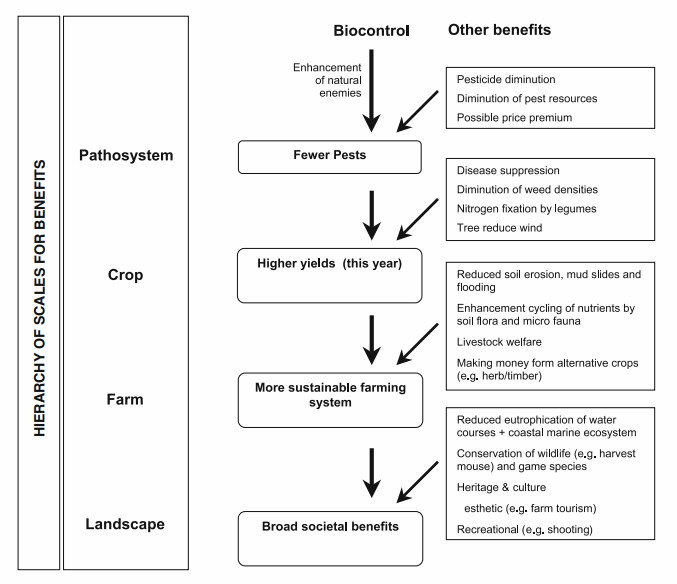Biodiversity, the variety of plants, animals, fungi, and microorganisms found in nature, is a vital natural resource for the health of the planet and of human societies, including agriculture. Sustainable and productive agricultural systems ultimately depend on biodiversity. Biodiversity is not only a concept that expresses "diversity of life" but also a socio-political construct and an ecologically measurable entity. Therefore, an operational definition of biodiversity is necessary for the identification of research directions, biological conservation measures, and the formulation of environmental policies. Biodiversity loss is now a global issue, with agriculture being a major driver. Every agricultural operation, including management, impacts biodiversity as it interferes with nature. Therefore, measures need to be taken in the field of agriculture, and assessment models suitable for large-scale use are needed.
 Fig. 1. The hierarchy of scale for potential benefits of multi-function agricultural biodiversity. (Clergue et al., 2009)
Fig. 1. The hierarchy of scale for potential benefits of multi-function agricultural biodiversity. (Clergue et al., 2009)
Agricultural areas have unique biodiversity that underpins human activities. Therefore, it is vital to conserve biodiversity in agricultural and protected areas. Lifeasible provides comprehensive crop biodiversity assessment solutions to understand the impacts of disturbances on biodiversity and to monitor their status and relevance to agri-environmental measures. We aim to promote sustainable agriculture by providing a rich genetic pool for preventing pests and diseases, ensuring food security, and breeding improved crop varieties.
We offer a variety of assessment tools to quantify and evaluate the impact of agricultural activities on biodiversity. Our biodiversity research is often focused on one scale: either habitat, patch scale, or at landscape scale.
Lifeasible provides state-of-the-art technology to ensure these indices are accurately represented, thus ensuring comprehensive biodiversity insights.
The complexity of biodiversity is not always visible through direct measurement. A broader picture of ecosystem health can be gained by understanding the dynamics of some key taxa. Lifeasible's extensive research into alternative metrics, such as biomarkers, demonstrates our commitment to innovation. By using these markers, we can predict overall trends in biodiversity with unparalleled accuracy.
The relationship between landscape composition and biodiversity is intricate and critical. Lifeasible ensures a more comprehensive understanding of ecosystems by measuring landscape parameters related to biodiversity.
We provide interaction matrices to assess the impact of agricultural production practices on different components of agroecosystems. We ensure that our solutions fulfill a holistic understanding of the ecosystem and facilitate informed decision-making.
Through our advanced assessment tools and methodologies, Lifeasible is ready to guide the agriculture industry toward a future where crop biodiversity is not only conserved but thrives. If you are interested in our services, please contact us for more information.
Reference
Lifeasible has established a one-stop service platform for plants. In addition to obtaining customized solutions for plant genetic engineering, customers can also conduct follow-up analysis and research on plants through our analysis platform. The analytical services we provide include but are not limited to the following:
STU-CRISPR System Improves Plant Genome Editing Efficiency
April 19, 2024
Application of Exosomes in Facial Beauty
April 12, 2024